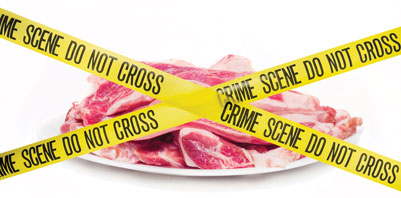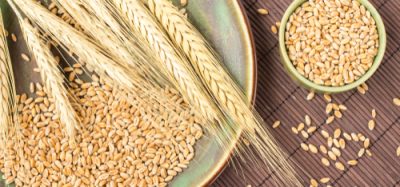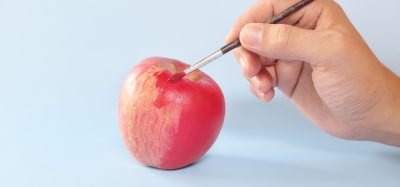Near Infrared: Food fraud and NIRS
- Like
- Digg
- Del
- Tumblr
- VKontakte
- Buffer
- Love This
- Odnoklassniki
- Meneame
- Blogger
- Amazon
- Yahoo Mail
- Gmail
- AOL
- Newsvine
- HackerNews
- Evernote
- MySpace
- Mail.ru
- Viadeo
- Line
- Comments
- Yummly
- SMS
- Viber
- Telegram
- Subscribe
- Skype
- Facebook Messenger
- Kakao
- LiveJournal
- Yammer
- Edgar
- Fintel
- Mix
- Instapaper
- Copy Link
Posted: 5 March 2014 | Saskia van Ruth, Head of Authenticity & Novel Foods Business Unit & Professor of Food Authenticity and Integrity and Rob Frankhuizen, Scientist, State Institute for Quality Control of Agricultural Products, RIKILT Wageningen University and Research Centre | No comments yet
Nowadays foods and ingredients are sourced from many different parts of the globe. Since the 1960s, global food transport has been increasing at an exponential rate, faster than food production itself. For certain countries, this network ensures access to any food item regardless of season or origin. The number of countries relying on international food trade has increased and traded food changed from raw materials towards processed and branded products. As a consequence, trade fluxes between countries to form a complex, extensive, intersecting network1. Optimised for rapid, low-cost production from all sources, it has consequently resulted in fragile networks that are vulnerable to food fraud that reaches every table in the world.


Traditional strategies for food authentication rely on the determination of a marker compound or compounds and the comparison of the obtained vales with those established for genuine material (Copyright Mila Atkovska / Shutterstock.com)
Food fraud may relate to compositional issues, e.g. certain constituents have been removed, added or substituted. Examples are product-foreign proteins or nitrogen-replacers in milk powders or hazelnut oil substituting olive oil, water addition to meat, husks to coffee, etc. Another category in food fraud concerns the product’s history, i.e. geographical origin, production practice (organic, animal welfare considering, sustainable, halal, etc.), and processing.
Food fraud risk: prevention and detection
Although negligence of rules and agreements plays a role, premeditation is the main issue in food fraud. Food fraud differs from most safety issues in that fraudsters intentionally aim at deceiving targets by food adulteration or counterfeiting for their own economic gain. Food fraud is a crime of calculation, not of passion. Although the primary intention of the fraudster is not to harm people, it may still result in serious food safety issues. Examples include the melamine case in China in which several infants died, dioxin problems in oils of unknown provenance, and anti-freeze in wine.
Rather than looking at specific incidents, a system analysis approach would be the preferred approach to prevent fraud in the future. For instance, by studying why putting melamine in products was perceived as a good fraud opportunity and how it could have been prevented. Generally, three things must be present for a fraudster to set to work: the opportunity to commit fraud, the incentive to commit fraud and the fraudster’s ability to rationalise their own actions2.
Although risk assessments exist for food safety and defence issues, fraud temptation has never been taken into account. A science-based assessment of fraud risks requires an interdisciplinary, inter-sectoral approach, i.e. an integrated analysis of technically feasible fraud openings, complexity of supply network structures, fraudster behaviour, safety management systems, as well as analytical detection methods. Since no one – producers, traders, importers, retailers and consumers – likes to be swindled, fraud prevention and detection is an important issue. Nowadays, authenticity of ingredients or products is mainly warranted by certification processes. Analytical tests which can help to confirm the authenticity of ingredients / products compose a very useful complementary approach to paper trailing.
Analytical methods
Traditional strategies for food authentication rely on the determination of a marker compound or compounds and the comparison of the obtained values with those established for genuine material. Examples include macro-component contents such as protein, fat, moisture and ash. The presence of an undesired adulterant in the situation of compositional fraud can be uncovered by checking for its presence in the food material, e.g. melamine in milk powders. However, an adulteration can be detected only if the adulterant is known beforehand and explicitly searched for by the analyst based on this conventional target analyses. Although with multi-methods several potential adulterants could be detected, it is not practically feasible and financially impossible to analyse foods for all potential adulterants. Furthermore, some aspects of food authenticity such as the geographical origin, the farming management systems (organic, free range, etc.), or the application of some specific processes cannot be dealt with those traditional approaches. For instance, no single markers exist for the unequivocal authentication of organic eggs or sustainable palm oil.
For these issues, a more holistic approach is needed based on the measurement and the evaluation of a pattern of compositional properties of the product at once, i.e. a fingerprinting approach comparing analytical properties of groups of products while taking into account the natural variation. Moreover, in industrial and laboratory settings, there is always the need for screening methods that are able to reliably identify those products that are potentially non-compliant before more detailed and accurate analysis with confirmatory methods is performed, i.e. the traffic light approach. Fingerprints can be generated with a wide range of analytical techniques. They can be obtained from chromatograms, spectroscopic measurements, spectral measurements or any other specific signal of complete spectra. The approach requires chemometrics in order to elucidate relationships between samples and to detect characteristic patterns that can be used to identify a certain material.
Near-infrared spectroscopy and food fraud detection
Near-infrared spectroscopy (NIRS) is one of the techniques that can be used for food authentication, either as a rapid alternative technique replacing a more laborious reference method or as a fingerprint approach. Its potential was discovered in the 1960s and the technique involves the measurement of a material’s tendency to absorb light in a certain area of electromagnetic radiation. The resulting spectrum is a fingerprint of the material. The near-infrared portion of the electromagnetic spectrum extends from 800 to 2,500nm, between the conventional mid-infrared region at longer wavelengths and the visible range at shorter wavelengths. The NIR spectrum is characterised by overtones and combination of the fundamental molecular vibrations of molecules containing C-H (e.g. in carbohydrates), N-H (e.g. in proteins), or O-H (e.g. in water) groups. The absorbance level at these specific wavelengths is generally proportional to the quantity of that constituent in the material3,4.
In view of food authentication, NIRS as a rapid alternative to targeted analysis with reference methods have been described to determine the major constituents of, for example, milk, milk powder, casein, butter and cheese with an accuracy similar to the accuracy obtained with the wet chemistry5,6; fat, water, protein, cholesterol, collagen and mineral contents of meat7; measurement of the iodine value of edible oils; caffeine in coffee; and ethanol in alcoholic beverages4.
Furthermore, NIRS have been applied in the fingerprint approach to detect compositional adulteration e.g. orange juice adulteration8, raspberry puree adulterations with apple puree9 and adulteration of pomegranate juice with grape juice10. Other studies on compositional adulteration include the identification of cattle, llama and horsemeat by NIRS11 and quantification of pork, fat trimming and offal in minced meat12. With regard to product history, some example studies demonstrate the use of NIRS for discrimination between organic and conventional production practices in asparagus production13, the reflection of cow feeding regimes in the spectral characteristics of cheese14, and discrimination between fresh and defrosted fish15.
NIRS and food fraud example: single marker and fingerprint approach for poultry meat
As an example of the potential of NIRS for food authentication, the results of an investigation that has been carried out in the authors’ research group will be shown. The water content of poultry meat varies with e.g. the birds’ breed, age, and production parameters. The water / protein ratio is an important parameter in legislation regulating the import of poultry meat into the EU, and a limit of 3.40 applies for a chicken breast’s water to protein ratio. The mean water and protein contents of poultry meat imported into the Netherlands analysed by wet chemistry reference methods has shown an increasing trend in water / protein ratio over the last decade (Figure 1). This may be due to a variety of reasons. Although the EU regulations prescribe the classical wet chemistry methods, rapid alternatives are useful for screening purposes.
In the present study, NIR spectra of a large group of poultry meat samples were generated. The spectral information was used to determine water and protein contents in poultry meat with the method calibrated against the wet chemistry reference methods. Furthermore, the spectral data was used as fingerprints in order to distinguish groups of samples. Regular poultry meat samples (176) as part of an EU control scheme (EC Regulation No. 543/2008) and 10 chicken breast samples with water and retaining agents added were subjected to analysis. After grounding and homogenising, the samples were analysed for their moisture and protein contents according to the classical wet chemistry methods (ISO 1442 and ISO 937 standards), respectively. For NIRS analysis, samples were packed into a circular large sample cup (140mm Ø by 14mm depth) and placed into the NIR spectrophotometer16. The samples were scanned in transmission in the low near infrared region (from 850-1050nm). The NIR spectra of 151 chicken breast samples were then compared to those in a database which included over 20,000 sample spectra of different sample types and associated reference values and included poultry meat. The moisture and protein contents were calculated using the mathematical algorithms of the Artificial Neural Network model. Model predictions and wet chemistry results were compared. The NIRS results were quite reproducible and correlated well with the wet chemistry results. The accuracy of the NIRS results was similar to the accuracy of the wet chemistry methods and therefore, a rapid alternative for the wet chemistry methodology.
In addition, the NIR spectra of the total test set (186 samples of poultry meat) were subjected to Principal Component Analysis (PCA). PCA of the data revealed that all prepared samples were well separated from the regular samples (Figure 2). A centre group composed of chicken breasts was separated from the group consisting of poultry cuts (thighs, drumsticks, legs, etc.) with bones. The chicken breast samples with added water and retaining agents were separated from the regular chicken breasts in the second dimension which is promising in view of food fraud detection.
Other food authenticity studies of the authors’ with NIRS include discrimination between wild and farmed salmon17, general anomaly detection in milk powders with regard to nitrogen-replacers such as melamine, ammonium chloride, caprolactam, diammonium, phosphate and polyvinylpyrrolidone17, geographical origin of coffee beans, and saffron adulteration.
Food fraud prevention future perspectives
In the future, when we have better understanding of the technological, criminological and situational factors that increase the risk of food fraud, dedicated food fraud assessments can be included in existing management systems. Rapid analytical detection techniques, which can screen for general anomalies in-/on-/at-line will help to control food authenticity. NIRS and hyperspectral imaging techniques are important techniques in this respect. Abnormal samples may then be subjected to further advanced confirmatory analyses in the laboratory.
References
- Ercsey-Ravasz, M., Toroczkai, Z., Lakner, Z., Baranyi, J. (2012) Complexity of the International Agro-Food Trade Network and Its Impact on Food Safety. PLoS ONE 7(5): e37810. doi:10.1371/journal.pone.0037810
- Bussmann, K.-D. (2007). Economic crime: people, culture and controls.The 4th biennial Global Economic Crime Survey. PricewaterhouseCoopers. pwc.com/crimesurvey
- Stark, E., Luchter, K., and Margoshes, M. (1986). Near-Infrared Analysis (NIRA): A Technology for Quantitative and Qualitative Analysis, Appl. Spectrosc., 22, 335
- Niemöller, A., Behmer, D. (2008). Use of Near Infrared Spectroscopy in the Food Industry. In: Non destructive testing of food quality, J. Irudayaraj & C. Reh (Editors), Blackwell Publishing Professional, Ames, Iowa, USA, pp. 67-118
- Frankhuizen, R., van der Veen, G. (1985). Determination of major and minor constituents in milk powders and cheese by near infra-red reflectance spectroscopy. Neth. Milk Dairy J. 39:191–207
- Blazquez, C., Downey, G., O’Donnell, C., OÇallaghan, D., Howard, V. (2004). Prediction of moisture, fat and inorganic salts in processed cheese by near infrared reflectance spectroscopy and multivariate data analysis, J. Near Infrared Spectr. 12:149-158
- Weeranantanaphan, J., Downey, G., Allen, P., Sun, D.W. (2011). A review of near infrared spectroscopy in muscle food analysis 2005-2010. J. Near Infrared Spectr. 19:61-104
- Twomey, M., Downey, G., Mc Nulty, P.B. (1995). The potential of NIR spectroscopy for the detection of the adulteration of orange juice. J. Sci. Food Agric. 67:77-84
- Contal, L., Leon, V., Downey, G. (2002). Detection and quantification of apple adulteration in strawberry and raspberry purees using visible and near infrared spectroscopy. J. Near Infrared Spectr. 10:289-299
- Vardin, H., Tay, A., Ozen, B., Mauer, L. (2008). Authentication of pomegranate juice concentrate using FTIR spectroscopy and chemometrics. Food Chem. 108:742-748
- Mamani-Linares, L.W., Gallo, C., Alomar, D. (2012). Identification of cattle, llama and horse meat by near infrared reflectance or transflectance spectroscopy. Meat Sci. 90:378–385
- Morsy, N., Su, D.-W. (2013). Robust linear and non-linear models of NIR spectroscopy for detection and quantification of adulterants in fresh and frozen-thawed minced beef. Meat Sci. 93:292–302
- Sánchez,-T., Garrido-Varo, A., Guerrero, J.-E., Pérez-Marín, D. (2013). NIRS technology for fast authentication of green asparagus grown under organic and conventional production systems. Postharvest Biol. Technol. 85:116–123
- Andueza, D., Agabriel, C., Constant, I., Lucas, A., Martin, B. (2013). Using visible or near infrared spectroscopy (NIRS) on cheese to authenticate cow feeding regimes. Food Chem. 141: 209–214
- Ottavian, M., Fasolato, L., Facco, P., Barolo, M. (2013). Foodstuff authentication from spectral data: Toward a species-independent discrimination between fresh and frozen–thawed fish samples. J. Food Engin. 119:765–775
- Anderson, S. (2007). Determination of fat, moisture and protein in meat and meat products by using the FOSS FoodScan Near-Infrared Spectrophotometer with FOSS Artificial Neural Network calibration model and associated database: Collaborative study. J. AOAC Int. 90:1073-1083
- Capuano, E. van Ruth, S.M. (2013). QA: fraud control of foods and other biomaterials by product fingerprinting. Latest Research in Quality Control 2. InTech Publishers, http://dx.doi.org/10.5772/51109
About the authors
Rob Frankhuizen studied Analytical Chemistry at the Chemical College in Leiden and Delft and Environmental Control at the Technical College in Amsterdam. From 1969 to 1976, he worked as a chemical engineer at the The Rijnland District Water Control Board in Leiden. In 1976, he started as a Research Assistant and since 1992, has worked as a Scientist at the State Institute for Quality Control of Agricultural Products (which is at present RIKILT Wageningen University and Research Centre in the Netherlands) with the implementation of instrumental techniques and related analytical chemistry. Since 1980, he has carried out research in the field of quality control, authentication and processing of a wide variety of food and feed products using NIRS in combination with chemometrics. He managed the Product Composition research programme from 2006 to 2009. From 1992 to 2010, he also acted as an independent NIRS Consultant and Assessor for the Dutch Accreditation Council (RvA). Rob has published more than 40 scientific papers, written around 80 RIKILT reports and participated in numerous national, EU and global projects / committees / networks.
Saskia van Ruth has headed up the Authenticity & Novel Foods business unit at RIKILT Wageningen University and Research Centre in the Netherlands since 2012. This post doubles with her position as Professor of Food Authenticity and Integrity at Wageningen University. She received her PhD in Food Chemistry from Wageningen University in 1995 and carried out research on lipid and volatiles chemistry as post-doctoral researcher for Unilever in 1996 to1998. From 1998 to 2005, she carried out instrumental flavour research at University College Cork, Ireland and lectured in sensory science and related analytical chemistry. Subsequently she joined RIKILT in 2005 and managed the research cluster Authenticity and Nutrients, and has managed the Product Composition research programme since 2009. Saskia’s research interests concern complex authentication issues with regard to production system (organic, sustainable, halal), geographical origin, processing, ingredients, and typicality (artisanal products) with application of state-of-the-art analytical methodology in combination with chemometrics. She has published more than 180 scientific papers and participated in numerous national, EU and global projects / committees / networks.







